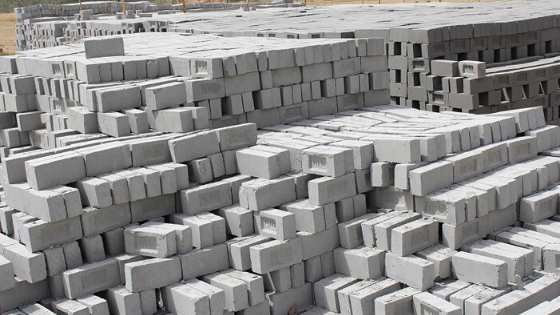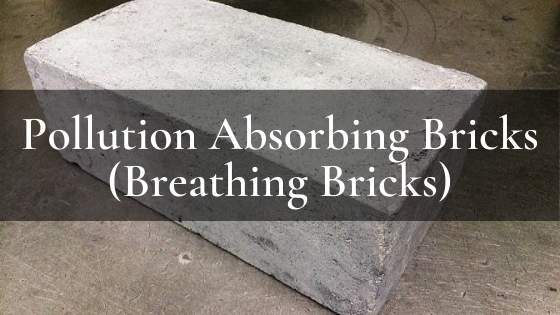
Fly ash bricks have gained popularity over clay bricks. Fly ash bricks are now being used worldwide. It has resulted in the conservation and protection of natural resources as well as the environment.
Fly ash bricks are manufactured from fly ash (which is an industrial waste), cement, sand and dust.
Fly ash bricks have better properties than normal clay bricks. These bricks can be used in non-load bearing internal or external walls in high rise buildings.
Sources of Fly Ash
Fly Ash is a burnt residue of pulverized coal that is siliceous in nature.
- Power plants – In India 72% of the power station in India is coal-based. Annually nearly 40 million tonnes of fly ash is produced by these power stations
- Industries – Industries using coal as fuel emits unwanted ash and smoke from which fly ash is produced.
In all the power plants and industries, fly ash is separate by using the cyclone converter and the fly ash is then used as a raw material for the manufacture of bricks.
Manufacturing of Fly Ash Bricks
The main composition of fly ash bricks are:- Fly ash, Cement, Sand and Water
The fly ash brick is a slow setting pozzolana cement mix. The process is the same as making cement in cement industries where the clay and limestone are burnt with coal and gypsum. And then these are mixed and ground with cement.
In fly ash mix, the fly ash which is burnt clay particles (oxides of clay) obtained from burning coal, which contains clay from the mines. When hydrated lime powder and gypsum are mixed and ground in a pan, the mixture gives a slow setting pozzolana cement.
While the mix is pressed at low pressure at low moisture content in a hydraulic machine, which is specially designed to give high-pressure load at a slow rate, in the order of 350kg/square inch. At this rate of pressure and withholding the pressure for the desired time gives the ultimate strength to fly ash bricks.
Properties of Fly Ash Bricks
Appearance
The appearance of fly ash bricks is very attractive due to its pleasing colours like cement, uniform size and smooth finish. Due to uniform size, mortar requirement for walls and plastering reduces almost 40-50 %. Plaster of Paris, putty can be applied directly without a baking coat of plaster. These bricks are free from cracks, wrap age, organic matter, pebbles and nodules of free lime.
Strength
The compressive strength of fly ash bricks is very high (i.e.9-10 N/mm2). Due to high strength, there is no breakages and wastages during transport and handling. The lower thickness of joints and plaster reduces cracking in plaster. These bricks do not cause any extra load for the design of structures and provide better earthquake resistance. It improves the strength over time and offers greater strength to the building.
Thermal properties
The thermal conductivity of fly ash brick is 0.90 to 1.05 W/m2. It absorbs less heat. The pozzolanic reaction between fly ash and lime produces less heat. It keeps buildings cooler in summer and hence it is most suitable for Indian climates.
Durability
Fly ash bricks are highly durable and less permeable. The lower permeability can efficiently reduce the effect of efflorescence on bricks. These bricks are less porous, absorbs less water and reduces dampness on the walls. It is also highly resistant to attack by mild acid, water and sulphate.
Fire resistance
Fly ash bricks are highly fire-resistant.
Sound insulation
Construction with fly ash bricks provides decent sound insulation to the building.
Availability of Fly Ash Bricks
These bricks are generally available closer to the thermal power plants. However, finding dealers in all major cities and towns wouldn’t be a problem.
Sustainability of Fly Ash Bricks
Fly ash bricks are environmentally friendly as they are made of wastes materials that come from combustion of coal in the thermal power plants. There is no pollution or environmental damage, considered as a white category product.
Cost of Fly Ash Bricks
The same number of fly ash bricks will cover more areas than clay bricks. Consumption of mortar is low. Requires less labour. The cost of fly ash bricks is approximately 30% lower than clay bricks.
Benefits of Fly Ash Bricks for Environment
The increase in greenhouse gases, out of which CO2 is one of the major constituents, increases the global warming year after year, causing drought and floods. In 1990, globally the total CO2 Emissions account for 24,960 million tonnes.
Cement and building material industry is one of the major contributors. About ninety million tonnes of CO2 emission is from the cement industry and forty-nine million tonnes from clay bricks production in India. As per the ongoing practices in India, each million clay bricks consume about 200 tonnes of coals and emit around 270 tonnes of CO2.
Fly ash bricks production in energy-free route saves the emissions totally, befitting the project to qualify under the Clean Development Mechanism (CDM), as envisaged by the Kyoto Protocol.
Comparison of Fly Ash Bricks and Clay Bricks
| S. No. | Properties | Fly Ash Bricks | Clay Bricks |
| 1 | Density | 1700-1850 kg/m3 | 1600-1750 kg/m3 |
| 2 | Compressive strength | 90-100 kg/cm2 | 30-35 kg/cm3 |
| 3 | Water absorption | 10-14% | 15-25% |
| 4 | Dimensional stability | High tolerance | Very low tolerance |
| 5 | Wastage during transit | Less than 2% | Up to 10% |
| 6 | Plastering | Even on both sides | Thickness varies on both sides of the wall |
Advantages of fly ash bricks
- Fly ash bricks are lightweight bricks. Less weight means less stress on the building. So it is suitable for multi-storey structures.
- Higher Compressive strength as compared to any conventional bricks.
- Lower water absorption as compared to conventional bricks.
- No efflorescence. Higher resistance to Salinity & water seepage.
- Smooth surfaces and uniform sizes.
- Better thermal properties.
- Thinner masonry joints with higher uniformity. Less cement mortar is required because of thin joints.
- Lesser number of bricks consumption because of regular full sizes.
- Saving in plastering due to lesser plaster thickness.
Disadvantages of fly ash bricks
- Fly ash bricks are only suitable for subtropical areas where climatic condition is warm because it does not absorb heat. But it is not suitable in the winter season.
- Not all fly ash is suitable for construction. Those which are produced in power plants are usually compatible with concrete while others may need beneficiation. It is very important to use only high-quality fly ash to prevent negative effects on the structure.
- If not made properly, it has no strength and not suitable for construction. Poor quality bricks have a negative impact on concrete. It can increase permeability, resulting in damages to the structure.
- Bonding with concrete is lower due to the smooth finish.
- Limitation in size. Only modular size bricks can be produced. The larger size will have more breakages.
Also Read: Fly Ash – Uses, Properties, Classification and Advantages


What’s bond strength evaluation of alkali activated fly ash brick?